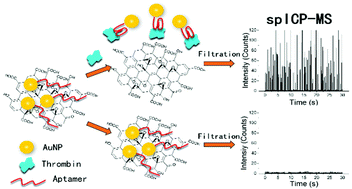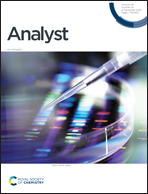Graphene/gold nanoparticle composites for ultrasensitive and versatile biomarker assay using single-particle inductively-coupled plasma/mass spectrometry†
Abstract
An ultrasensitive and versatile assay for biomarkers has been developed using graphene/gold nanoparticles (AuNPs) composites and single-particle inductively-coupled plasma/mass spectrometry (spICP-MS). Thrombin was chosen as a model biomarker for this study. AuNPs modified with thrombin aptamers were first non-selectively adsorbed onto the surface of graphene oxide (GO) to form GO/AuNPs composites. In the presence of thrombin, the AuNPs desorbed from the GO/AuNPs composites due to a conformation change of the thrombin aptamer after binding with thrombin. The desorbed AuNPs were proportional to the concentration of thrombin and could be quantified by spICP-MS. By counting the individual AuNPs in the spICP-MS measurement, the concentration of thrombin could be determined. This assay achieved an ultralow detection limit of 4.5 fM with a broad linear range from 10 fM to 100 pM. The method also showed excellent selectivity and reproducibility when a complex protein matrix was evaluated. Furthermore, the diversity and ready availability of ssDNA ligands make this method a versatile new technique for ultrasensitive detection of a wide variety of biomarkers in clinical diagnostics.



 Please wait while we load your content...
Please wait while we load your content...
